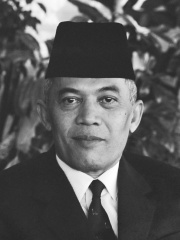
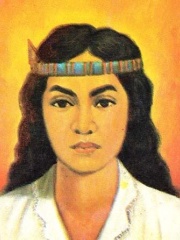
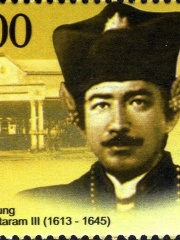
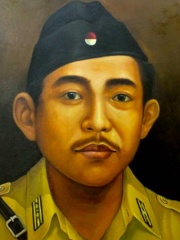
The Most Famous
MILITARY PERSONNELS from Indonesia
This page contains a list of the greatest Indonesian Military Personnels. The pantheon dataset contains 2,058 Military Personnels, 5 of which were born in Indonesia. This makes Indonesia the birth place of the 45th most number of Military Personnels behind Denmark, and Argentina.
Top 5
The following people are considered by Pantheon to be the most legendary Indonesian Military Personnels of all time. This list of famous Indonesian Military Personnels is sorted by HPI (Historical Popularity Index), a metric that aggregates information on a biography's online popularity.

1. Abdul Haris Nasution (1918 - 2000)
With an HPI of 60.18, Abdul Haris Nasution is the most famous Indonesian Military Personnel. His biography has been translated into 23 different languages on wikipedia.
Abdul Haris Nasution (Old Spelling: Abdoel Haris Nasution; 3 December 1918 – 6 September 2000) was a high-ranking Indonesian general and politician. He served in the military during the Indonesian National Revolution and remained in the military during the subsequent turmoil of the Parliamentary democracy and Guided Democracy. Following the fall of President Sukarno from power, he became the Speaker of the People's Consultative Assembly under President Suharto. Born into a Batak Muslim family, in the village of Hutapungkut, Dutch East Indies, he studied teaching and enrolled at a military academy in Bandung. He became a member of the Royal Netherlands East Indies Army, but following the Japanese invasion, he joined the Defenders of the Homeland. Following the proclamation of independence, he enlisted in the fledgling Indonesian armed forces and fought during the Indonesian National Revolution. In 1946, he was appointed commander of the Siliwangi Division, the guerrilla unit operating in West Java. After the end of the national revolution, he was appointed Chief of Staff of the army, until he was suspended for his involvement in the 17 October affair. He was reappointed to the position in 1955. In 1965, an attempted coup occurred, later officially blamed on the Communist Party of Indonesia. Nasution's house was attacked, and his daughter was killed, but he managed to escape by scaling a wall and hiding in the Iraqi ambassador's residence. In the following political turmoil, he assisted in the rise of President Suharto and was appointed Speaker of the People's Consultative Assembly. He had a falling-out with Suharto, who saw him as a rival, and he was pushed out of power in 1971. Once he was removed from positions of power, Nasution developed into a political opponent of Suharto's New Order Regime, though he and Suharto began to reconcile in the 1990s. He died on 6 September 2000 in Jakarta, after suffering a stroke and going into a coma. His body was interred at Kalibata Heroes' Cemetery.

2. Martha Christina Tiahahu (1800 - 1818)
With an HPI of 59.98, Martha Christina Tiahahu is the 2nd most famous Indonesian Military Personnel. Her biography has been translated into 18 different languages.
Martha Christina Tiahahu (4 January 1800 – 2 January 1818) was a Moluccan freedom fighter and National Heroine of Indonesia. Born to a military captain, Tiahahu was active in military matters from a young age. She joined the war led by Pattimura against the Dutch colonial government when she was 17, fighting in several battles. After being captured in October 1817, she was released on account of her age. She continued to fight, and was captured again. Sent to Java to be a slave labourer, she fell ill on the way and, refusing to eat or take medicine, died on a ship in the Banda Sea. Tiahahu is considered a National Heroine of Indonesia. She has also been honoured with two statues, one in Ambon and one in Abubu; other namesakes include a warship, street, Moluccan social organization, and women's magazine.

3. Sultan Agung of Mataram (1593 - 1645)
With an HPI of 59.89, Sultan Agung of Mataram is the 3rd most famous Indonesian Military Personnel. His biography has been translated into 17 different languages.
Sultan Agung Adi Prabu Anyakrakusuma (Javanese: ꦱꦸꦭ꧀ꦠꦤ꧀ꦲꦒꦸꦁꦲꦢꦶꦥꦿꦧꦸꦲꦚꦏꦿꦏꦸꦱꦸꦩ), commonly known as Sultan Agung, was the third Sultan of Mataram in Central Java ruling from 1613 to 1645. He was a skilled soldier who conquered neighbouring states and expanded and consolidated his kingdom to its greatest territorial and military power. Sultan Agung or Susuhunan Agung (literally, "Great Sultan" or "Majestic Sultan") is subject to a substantial amount of literature due to his legacy as a Javanese ruler, a fighter against the incursions of the Dutch East India Company, a conqueror, and his existence within a cultural framework where myth and magic are intertwined with verifiable historical events and personages. The Dutch literature wrote his name as Agoeng de Grote (literally, "Agung the Great"). For his service as a fighter and cultural observer, Sultan Agung was declared as National Hero of Indonesia on November 3, 1975.

4. I Gusti Ngurah Rai (1917 - 1946)
With an HPI of 59.15, I Gusti Ngurah Rai is the 4th most famous Indonesian Military Personnel. His biography has been translated into 19 different languages.
Colonel I Gusti Ngurah Rai (30 January 1917 – 20 November 1946) was an Indonesian National Hero who commanded Indonesian forces in Bali against the Dutch during the Indonesian War of Independence. He was killed in the Battle of Margarana.
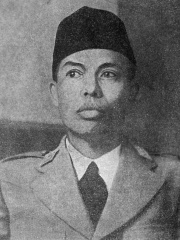
5. Sudirman (1916 - 1950)
With an HPI of 56.60, Sudirman is the 5th most famous Indonesian Military Personnel. His biography has been translated into 19 different languages.
Sudirman (Old Spelling: Soedirman; 24 January 1916 – 29 January 1950) was an Indonesian military officer and revolutionary during the Indonesian National Revolution and the first commander of the Indonesian National Armed Forces. Born in Purbalingga, Dutch East Indies, Sudirman moved to Cilacap in 1916 and was raised by his uncle. A diligent student at a Muhammadiyah-run school, he became respected within the community for his devotion to Islam. After dropping out of teacher's college, in 1936 he began working as a teacher, and later headmaster, at a Muhammadiyah-run elementary school. After the Japanese occupied the Indies in 1942, Sudirman continued to teach, before joining the Japanese-sponsored Defenders of the Homeland (PETA) as a battalion commander in Banyumas in 1944. In this position he put down a rebellion by his fellow soldiers, but was later interned in Bogor. After Indonesia proclaimed its independence on 17 August 1945, Sudirman led a break-out then went to Jakarta to meet President Sukarno. Tasked with overseeing the surrender of Japanese soldiers in Banyumas, he established a Division of the People's Safety Body there. On 12 November 1945, at an election to decide the military's commander-in-chief in Yogyakarta, Sudirman was chosen over Oerip Soemohardjo in a Close vote. While waiting to be confirmed, Sudirman ordered an assault on British and Dutch forces in Ambarawa. The ensuing battle and British withdrawal strengthened Sudirman's popular support, and he was ultimately confirmed on 18 December. During the following three years Sudirman saw negotiations with the returning Dutch colonial forces fail, first after the Linggadjati Agreement – which Sudirman participated in drafting – and then the Renville Agreement; he was also faced with internal dissent, including a 1948 coup d'état attempt. He later blamed these issues for his tuberculosis, which led to his right lung collapsing in November 1948. On 19 December 1948, several days after Sudirman's release from the hospital, the Dutch launched an assault on the capital. Sudirman and a small contingent escaped Dutch forces and left the city, making their headquarters at Sobo, near Mount Lawu. There Sudirman commanded military activities throughout Java, including a show of force in Yogyakarta on 1 March 1949. When the Dutch began withdrawing, in July 1949 Sudirman was recalled to Yogyakarta and forbidden to fight further. In late 1949 Sudirman's tuberculosis relapsed, and he retired to Magelang, where he died slightly more than a month after the Dutch recognised Indonesia's independence. He is buried at Semaki Heroes' Cemetery in Yogyakarta. Sudirman's death was mourned throughout Indonesia, with flags flown at half-mast and thousands gathering to see his funeral convoy and procession. He continues to be highly respected in Indonesia. His guerrilla campaign has been credited with developing the army's esprit de corps, and the 100-kilometre (62 mi) long route he took must be followed by Indonesian cadets before graduation. Sudirman featured prominently on the 1968 series of rupiah banknotes, and has numerous streets, museums, and monuments named after him. On 10 December 1964, he was declared a National Hero of Indonesia.
People
Pantheon has 5 people classified as Indonesian military personnels born between 1593 and 1918. Of these 5, none of them are still alive today. The most famous deceased Indonesian military personnels include Abdul Haris Nasution, Martha Christina Tiahahu, and Sultan Agung of Mataram.
Deceased Indonesian Military Personnels
Go to all RankingsAbdul Haris Nasution
1918 - 2000
HPI: 60.18
Martha Christina Tiahahu
1800 - 1818
HPI: 59.98
Sultan Agung of Mataram
1593 - 1645
HPI: 59.89
I Gusti Ngurah Rai
1917 - 1946
HPI: 59.15
Sudirman
1916 - 1950
HPI: 56.60
Overlapping Lives
Which Military Personnels were alive at the same time? This visualization shows the lifespans of the 4 most globally memorable Military Personnels since 1700.

